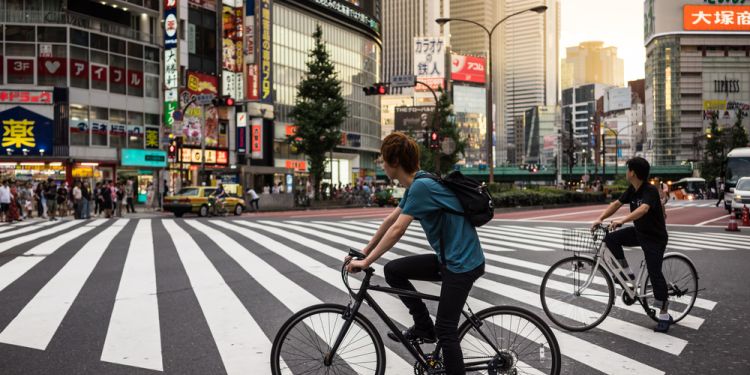
Sometimes cycling in a city is not only an environmentally-friendly and healthy way to get to work, it can also be the quickest way to get there. Whether you just love cycling, or are looking to get to work without having to deal with public transport or the inevitable rush-hour traffic, here are some of 2017's most cycle-friendly cities, according to Copenhagenize.
The Nordic countries

Holding onto first place, Copenhagen has seen a range of investment, from physical infrastructure in the form of numerous bicycle bridges and superhighways, to tech in the form of digital traffic signs to improve congestion. With more people cycling into the city than driving, all the hard work seems to have paid off.
The only Swedish feature on the list, Malmö has a good cycling culture that sees it take fifth place. The introduction of a bike-ferry between the city and top-of-the-list Copenhagen also allows cyclists to enjoy public transport that can take them further afield. Another innovation in the city comes in the form of the Cykelhuset, which is an apartment building catered to car-free residents, with sustainability at its heart.
Finland's capital city Helsinki features in 18th, and with a long history of cycling, it comes as no surprise. However, the infrastructure is similarly historic, with a need for new infrastructure to keep up with the popularity for cycling.
The final Nordic city in the list is Oslo at 19th, with future plans to make its city centre accessible only to pedestrians, cyclists and public transport. It currently has a bike-sharing system and intends to improve its infrastructure over the coming years.
The Netherlands

In third place, Amsterdam is internationally well-known as cyclists' haven, where it is undoubtedly the primary form of transportation. Though it doesn't have a traditional bike-sharing scheme, there are bike rental shops at every turn. However, if you're commuting in Amsterdam, you'll definitely want your own set of wheels. Another city in the Netherlands to make the list is the small city of Utrecht, which has pipped the country's capital to second. As with Amsterdam, there are roads solely for bike traffic, and an advanced decongestion system that analyses cyclists speed also helps keep everyone on the move.
France

Fourth place Strasbourg is currently the most well-developed city in France for cyclists, with a plan for cycle superhighways in the works. Its renowned Velhop bike sharing scheme makes it even easier for visitors and commuters to get around. The city of Bordeaux in general seems to be popular amongst cyclists, and with the historic architecture and views one would get to enjoy on a daily commute, it is understandable. However, the city (in sixth place) is now moving to invest more in making the city a more cyclist-friendly environment. France's capital has moved up to 13th, and there are plans afoot to make the city even more cycle-friendly and expand its existing bike-sharing scheme as well as pedestrianise certain areas. Nantes, on the other hand, has dropped almost ten places to 16th, with no short-term increase in the percentage of cyclists or significant improvements to infrastructure. In spite of this, there are indications that cycling is on the up, such as an increasing use of cargo bikes.
Germany

Germany's highest city featured is Berlin in tenth, and this is largely down to the sheer number of people choosing to cycle in the city (both commuters and those using cargo bikes), rather than existing infrastructure. However, change is in the wind, with a renewed focus on cycling and sustainable transport. Munich has jumped back into the top twenty at number 15, following a brief disappearance. The city has a high percentage of cyclists (as opposed to other modes of transport) and an extensive network (with plans to extend it further with additional superhighways). Finally, in 17th, is Hamburg, which provides a contrast to Munich's renewed focus on cycling, due to its reliance on existing infrastructure to maintain its position. One issue to note is that visitors and new members of the city may have a harder time making the most of the existing infrastructure.
Spain

At number 11, Barcelona is undergoing development in its cycling infrastructure, from an increase in cycling routes to 'Superblocks' restricting vehicular traffic on smaller roads. It also has a popular bike-sharing scheme. Seville, on the other hand, has slipped four places to 14th due to a lack of improvement in existing infrastructure. However, there are plans to expand the existing cycling network in the pipeline.
Other European countries

The Belgian city of Antwerp has had a somewhat turbulent ride in the previous editions of the index, however it has moved up to seventh place this year, with plans to extend its bike-sharing scheme and the continuing implementation of modern bike racks. Similarly to a number of the other countries, the city is looking at long-term investment in infrastructure.
Perhaps a bit of an unknown name given some of the other major cities in the index, Ljubljana in Slovenia is eighth, jumping up five places. It has upped its promotion of cycling and has benefited from a year as Europe's Green Capital in 2016. This has helped accelerate the city's plans to encourage cycling.
With a jump of four places, 12th place Vienna has had several developments come to fruition, such as a (currently) unique cargo bike share system in addition to traditional bike-sharing. The vehicular traffic here isn't quite intense as some other cities, making it an all around more enjoyable cycling experience.
The rest of the world

Further afield there are just two countries that make it on the list, with Europe dominating the top positions. Tokyo is a new feature in ninth, and being one of the most densely populated urban areas, it makes sense that cycling is simply one of the easiest ways to get around. Though the investment in cycling has not been profound, there is good infrastructure in the form of bicycle racks and parking. Taking the final spot is Montréal, Canada, with the implementation of new infrastructure and cycle paths, though there is room for improvement. However, there are several regions with no representation in the top twenty, highlighting that, outside of Europe, there is a long way to go before any city you move to is cycle-friendly.



















